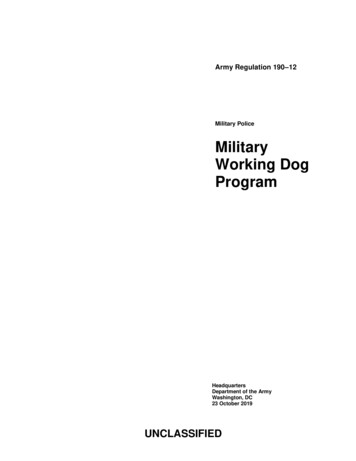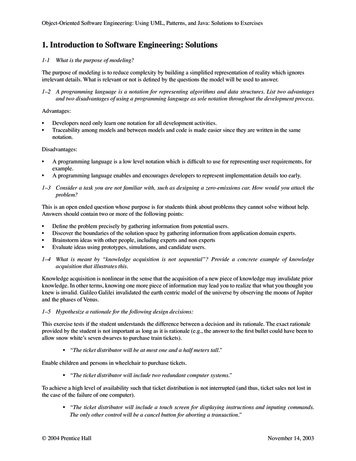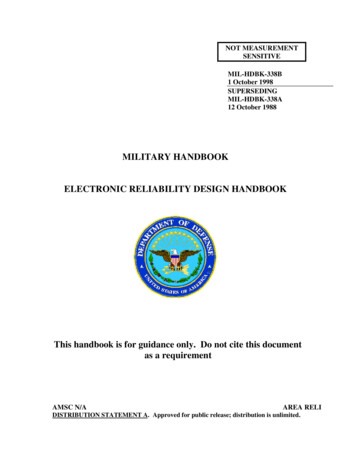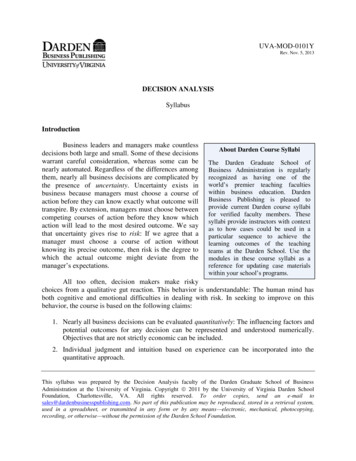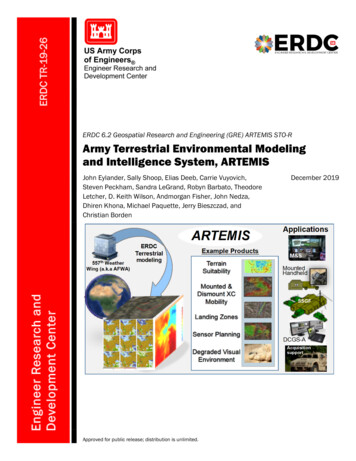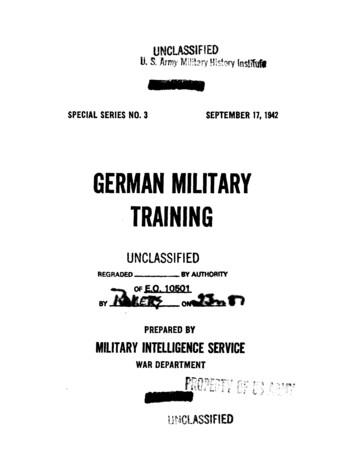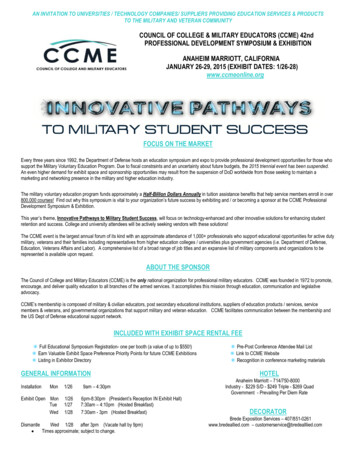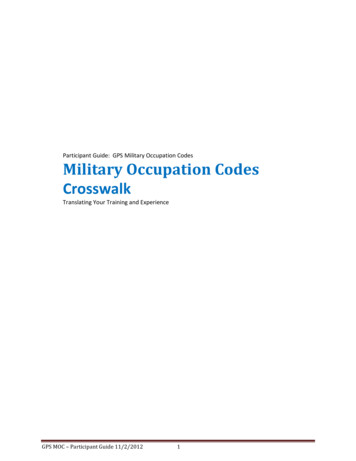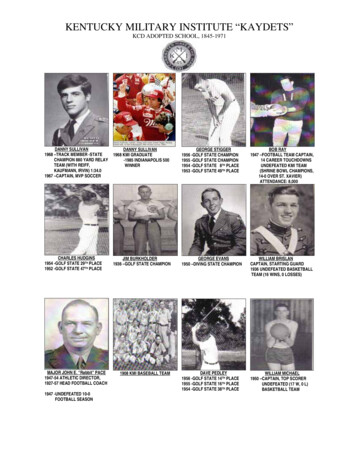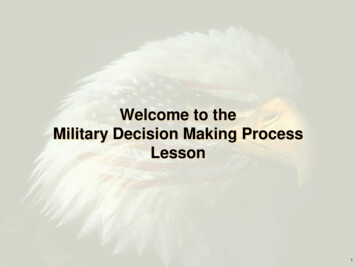
Transcription
Welcome to theMilitary Decision Making ProcessLesson1Version 13-01ATTP, Mr. Raun Watson, CTAC, 913.684-2422
Military Decision Making ProcessWelcome to the P920 US Army Military Decision Making Process (MDMP)Lesson. This Lesson provides an overview of the US Army’s MDMP, anestablished and proven detailed planning process.The MDMP is an iterative planning methodology that integrates theactivities of the commander, staff, subordinate headquarters, and otherpartners to understand the situation and mission; develop and comparecourses of action; decide on a course of action that best accomplishes themission; and produce an operation plan or order for execution.The MDMP helps leaders apply thoroughness, clarity, sound judgment,logic, and professional knowledge to understand situations, develop optionsto solve problems, and reach decisions. This process helps commanders,staffs, and others think critically and creatively while planning.Three doctrinal references have been selected for this lesson: ADP 3-0, Unified Land Operations (Oct 11)[Supersedes FM 3-0, Operations, with Change 1, Feb 11] ATTP 5-0.1, Commander and Staff Officer Guide (Sep 11) FM 1-02, Operational Terms and Graphics (Sep 04), with Change 1 (20 Feb 10)Each slide contains a doctrinal reference at the bottom right corner which indicates the FM, date, page, or paragraph number.2Version 13-01ATTP, Mr. Raun Watson, CTAC, 913.684-2422
MDMP Key ConceptsThis Lesson is designed to provide an overview of the following: The Commander’s Role in MDMP. The role of the commander in missioncommand is to direct and lead from the beginning of planning throughoutexecution, and to assess continually. To ensure mission accomplishment,the commander understands, visualizes, describes, directs, leads, andassesses operations. The Staff’s Role in MDMP. The staff’s effort during the MDMP focuses onhelping the commander understand the situation, making decisions, andsynchronizing those decisions into a fully developed plan or order. TheChief of Staff (COS) or Executive Officer (XO) manages and coordinatesthe staff’s work and provides quality control. Commander, Staff, and Subordinate Interaction. The MDMP is designedto facilitate interaction between the commander, staff, and subordinateheadquarters throughout planning. Performing the MDMP. The MDMP consists of seven steps. Thecommander and staff generally perform these steps sequentially;however, they may revisit several steps in an iterative fashion as theylearn more about the situation before producing the plan or order.RATTP 5-0.1, Commander and Staff Officer Guide, Sep 11, p. 4-23Version 13-01ATTP, Mr. Raun Watson, DTAC, 913.684-2422
Military Decision Making ProcessThis lesson consists of eight sections: Introduction to the MDMP Step 1 - Receipt of Mission Step 2 - Mission Analysis Step 3 - Course of Action Development Step 4 - Course of Action Analysis Step 5 - Course of Action Comparison Step 6 - Course of Action Approval Step 7 - Orders ProductionNote: A glossary is provided for newly introduced terms. These terms are identified by underlining andare hyperlinked to the glossary page at the end of each Section.4Version 13-01ATTP, Mr. Raun Watson, DTAC, 913.684-2422
Military Decision Making ProcessThis lesson consists of eight sections: Introduction to the MDMP MDMP and Unified Land Operations The Commander’s Role in MDMP The Staff’s Role in MDMP Army Problem-Solving and the MDMP Step 1 - Receipt of Mission Step 2 - Mission Analysis Step 3 - Course of Action Development Step 4 - Course of Action Analysis Step 5 - Course of Action Comparison Step 6 - Course of Action Approval Step 7 - Orders Production5Version 13-01ATTP, Mr. Raun Watson, DTAC, 913.684-2422
MDMP and Unified Land Operations The P920 Doctrine Lesson provided an overview ofthe foundations of unified land operations as theArmy’s warfighting doctrine. It is based on the centralidea that Army units seize, retain, and exploit theinitiative to gain a position of relative advantage overthe enemy. This is executed through decisive action,by means of core competencies, and guided bymission command. The philosophy of mission command - the exercise of authority anddirection by the commander using mission orders to enable disciplinedinitiative within the commander’s intent - guides leaders in theexecution of unified land operations. The operations structure is the Army’sconstruct for operations. Within thisconstruct, the operations process providesa broadly defined approach to developingand conducting operations. This is thecontext for MDMP.NADP 3-0, Unified Land Operations, Oct 11, para 19, 38 - 436Version 13-01ATTP, Mr. Raun Watson, DTAC, 913.684-2422
MDMP and Unified Land OperationsOperations Process Plan Army Design Methodology MDMP TLP Prepare Execute Assess Within the operations process, planning is the art andscience of understanding a situation, envisioning a desiredfuture, and laying out effective ways of bringing about thatfuture. Planning consists of two separate but closelyrelated components: conceptual and detailed. Successful planningrequires integrating both components. Army leaders employ three methodologies for planning afterdetermining the appropriate mix based on the scope of the problem,their familiarity with it, and the time available: The Army design methodology is a used for applying critical and creativethinking to understand, visualize, and describe unfamiliar problems andapproaches to solving them. Leaders integrate this aid to conceptual thinkingmethodology with the detailed planning associated with the MDMP. The military decisionmaking process (MDMP) is an iterative planningmethodology. The MDMP applies both conceptual and detailed approaches tothinking but is most closely associated with detailed planning. This detailedplanning process is the focus of the MDMP Lesson. Troop leading procedures (TLP) are a dynamic process used by small-unitleaders and typically not employed in organizations with staffs.NADP 3-0, Unified Land Operations, Oct 11, paras 40 - 437Version 13-01ATTP, Mr. Raun Watson, DTAC, 913.684-2422
The Commander’s Role in MDMP The MDMP is an iterative planning methodology. It integrates theactivities of the commander, staff, subordinate headquarters, and otherpartners to understand the situation and mission; develop, analyze,and compare courses of action; decide on a course of action that bestaccomplishes the mission; and produce an operation order or order forexecution. Commanders initiate the MDMP upon receipt of or in anticipation of amission. Commanders and staff often begin planning in the absence ofa complete and approved higher headquarters’ operation plan (OPLAN)or operation order (OPORD). The commander is the most important participant in the MDMP. Morethan simply decisionmakers in this process, commanders use theirexperience, knowledge, and judgment to guide staff planning efforts. While unable to devote all their time to the MDMP, commandersremain aware of the current status of the planning effort, participateduring critical periods of the process, and make sound decisions basedon the detailed work of the staff.RADP 3-0, Unified Land Operations, Oct 11, para 42ATTP 5-0.1, Commander and Staff Officer Guide, Sep 11, p. 4-28Version 13-01ATTP, Mr. Raun Watson, DTAC, 913.684-2422
The Staff’s Role in MDMP The chief of staff (COS) or executive officer (XO) is a key participant in theMDMP. He manages and coordinates the staff’s work and providesquality control during the MDMP. He must clearly understand thecommander’s intent and guidance because he supervises the entireprocess. He provides time lines, establishes briefing times and locations,and provides any instructions necessary to complete the plan. The staff’s effort during the MDMP focuses on helping the commanderunderstand the situation, making decisions, and synchronizing thosedecisions into a fully developed plan or order. Staff activities during planning initially focuson mission analysis. Mission analysis productshelp the commander understand the situationand develop the commander’s visualization. During course of action (COA) developmentand COA comparison, the staff providesrecommendations to support the commanderin selecting a COA. After the commandermakes a decision, the staff prepares the planor order, coordinating all necessary details.RATTP 5-0.1, Commander and Staff Officer Guide, Sep 11, p. 4-29Version 13-01ATTP, Mr. Raun Watson, DTAC, 913.684-2422
Overview of the MDMPINPUT HIGHER HQ PLAN or ORDERHIGHER HQ KNOWLEDGE and INTELPRODUCTSKNOWLEDGE PRODUCTS from OTHERORGANIZATIONSDESIGN CONCEPT (if developed) MISSION STATEMENTINITIAL CDR’S INTENT, PLANNINGGUIDANCE, CCIRs, and EEFIsUPDATED IPB and RUNNING ESTIMATESASSUMPTIONS UPDATED RUNNING ESTIMATESREVISED PLANNING GUIDANCECOA STATEMENTS and SKETCHESUPDATED ASSUMPTIONS UPDATED RUNNING ESTIMATESREFINED COAsEVALUATION CRITERIAWAR-GAME RESULTSUPDATED ASSUMPTIONS UPDATED RUNNING ESTIMATESEVALUATED COAsRECOMMENDED COAUPDATED ASSUMPTIONS RHIGHER HQ PLAN or ORDER or NEWMISSION ANTICIPATED by theCOMMANDERCDR-SELECTED COA with anyMODIFICATIONSREFINED CDR’s INTENT, CCIRs, and EEFIsUPDATED ASSUMPTIONSSTEPOUTPUT CDR’S INITIAL GUIDANCEINITIAL ALLOCATION of TIME PROBLEM STATEMENTMISSION STATEMENTINITIAL CDR’S INTENTINITIAL PLANNING GUIDANCEINITIAL CCIRs and EEFIsUPDATED IPB and RUNNING ESTIMATESASSUMPTIONS3 - COA DEVELOPMENT COA STATEMENTS and SKETCHESTENTATIVE TASK ORGANIZATIONBROAD CONCEPT of OPERATIONSREVISED PLANNING GUIDANCEUPDATED ASSUMPTIONS4 - COA ANALYSIS REFINED COAsPOTENTIAL DECISION POINTSWAR-GAME RESULTSINITIAL ASSESSMENT MEASURESUPDATED ASSUMPTIONS5 - COA COMPARISON EVALUATED COAsRECOMMENDED COAsUPDATED RUNNING ESTIMATESUPDATED ASSUMPTIONS6 - COA APPROVAL CDR-SELECTED COA and MODIFICATIONSREFINED CDR’S INTENTREFINED CCIRs and EEFIsUPDATED ASSUMPTIONS APPROVED OPERATION PLAN or ORDER1 - RECEIPT OF MISSIONWARNO 12 - MISSION ANALYSISWARNO 2(WAR-GAME)WARNO 37 - ORDERS PRODUCTIONATTP 5-0.1, Cdr/Staff Officer Guide, Sep 11, Modified from Fig 4-1, p. 4-310Version 13-01ATTP, Mr. Raun Watson, DTAC, 913.684-2422
Military Decision Making ProcessThis lesson consists of eight sections: Introduction to the MDMP Step 1 - Receipt of Mission Step 2 - Mission Analysis Step 3 - Course of Action Development Step 4 - Course of Action Analysis Step 5 - Course of Action Comparison Step 6 - Course of Action Approval Step 7 - Orders Production11Version 13-01ATTP, Mr. Raun Watson, CTAC, 913.684-2422
1 - RECEIPT OF MISSION2 - MISSION ANALYSIS3 - COA DEVELOPMENTStep 1 – Receipt of Mission4 - COA ANALYSIS(WAR GAME)5 - COA COMPARISON The MDMP begins with receiving or anticipating a new mission.6 - COA APPROVAL7 - ORDERS PRODUCTION This mission can come from an order issued by higherheadquarters or be derived from an ongoing operation. The purpose of this step is to alert all participants of the pendingplanning requirements, determine the amount of time available forplanning and preparation, and decide on a planning approach, includingguidance on design and how to abbreviate the MDMP, if required. When a new mission is identified,commanders and staffs performprocess actions and produce outputs. Receipt of mission consists ofsix tasks, shown in the process andoutput columns on the next slide.Each task will be described insubsequent slides. (Some subjects will bediscussed in greater detail during the conduct ofCGSS).RATTP 5-0.1, Cdr/Staff Officer Guide, Sep 11, pp. 4-4 to 4-512Version 13-01ATTP, Mr. Raun Watson, CTAC, 913.684-2422
Introduction to Step 1 - Receipt of MissionINPUTPROCESS Mission from higher HQ ordeduced by the commanderand staff. Alert the staff and other keyparticipants. Commander’s initialguidance. Gather the tools: Higher HQ order Maps SOPs Appropriate FMs Running estimates Other as required Initial Warning Order(WARNO) # 1. Higher HQ plan, OPORD,or WARNOs.OUTPUT Update running estimates. Conduct initial assessment.ATTP 5-0.1, Cdr/Staff Officer Guide, Sep 11, pp. 4-4 to 4-513Version 13-01ATTP, Mr. Raun Watson, CTAC, 913.684-2422
1 - RECEIPT OF MISSION2 - MISSION ANALYSIS3 - COA DEVELOPMENTStep 1 - Receipt of Mission4 - COA ANALYSIS(WAR GAME)5 - COA COMPARISON6 - COA APPROVAL7 - ORDERS PRODUCTION Input: The MDMP begins with receiving or anticipating a newmission. This can come from an order issued by higherheadquarters or be derived from an ongoing operation. Process: Step 1 - Receipt of Mission involves six tasks: Task 1, Alert the staff and other key participants. As soon as theunit receives a new mission (or when the commander directs), thecurrent operations integration cell (G-3 / S-3) alerts the staff. Unitstanding operating procedures (SOPs) should identify whoparticipates in mission analysis. Task 2, Gather the tools. These tools include, but not limited to thehigher headquarters order or plan and operational graphics; mapsand terrain products of the area of operations (AO); SOPs;appropriate field manuals (FMs); current running estimates; anydesign products; and other materials and products required. Task 3, Update running estimates. Each staff section should beginupdating its running estimate - especially the status of friendly unitsand resources and key civil considerations. Updating runningestimates is continuous throughout the operations process.ATTP 5-0.1, Cdr/Staff Officer Guide, Sep 11, pp. 4-4 to 4-514Version 13-01ATTP, Mr. Raun Watson, CTAC, 913.684-2422
1 - RECEIPT OF MISSION2 - MISSION ANALYSIS3 - COA DEVELOPMENTStep 1 - Receipt of Mission4 - COA ANALYSIS(WAR GAME)5 - COA COMPARISON6 - COA APPROVAL7 - ORDERS PRODUCTION Input: The MDMP begins with receiving or anticipating a newmission. This can come from an order issued by higherheadquarters or be derived from an ongoing operation. Process: Step 1 - Receipt of Mission involves six tasks: Task 4, Conduct initial assessment. The commander and staffperform an initial assessment. This includes: The time needed to plan and prepare for the mission for both theheadquarters and subordinate units. Commanders generally allocate aminimum of two-thirds of the available time to subordinate units forplanning and preparation. This leaves one-third of the time for thecommander and staff to do their own planning. The COS / XO thendetermines the staff planning time line that outlines how long the staffcan spend on each MDMP step. Guidance on design and abbreviating the MDMP, if required. Time, morethan any other factor, determines the detail to which the commanderand staff can plan. Which outside agencies and organizations to contact and incorporateinto the planning process. The staff’s experience, cohesiveness, and level of rest or stress.ATTP 5-0.1, Cdr/Staff Officer Guide, Sep 11, p. 4-515Version 13-01ATTP, Mr. Raun Watson, CTAC, 913.684-2422
1 - RECEIPT OF MISSION2 - MISSION ANALYSIS3 - COA DEVELOPMENTStep 1 - Receipt of Mission4 - COA ANALYSIS(WAR GAME)5 - COA COMPARISON Output: Step 1 - Receipt of Mission consists of:6 - COA APPROVAL7 - ORDERS PRODUCTION Task 5, Issue the commander’s initial guidance. Once time is allocated,the commander determines whether to initiate design, conduct designand MDMP in parallel, or proceed directly into the MDMP without thebenefits of formal design activities. The initial guidance includes: Initial time allocations. A decision to initiate design or go straight into the MDMP. How to abbreviate the MDMP, if required. Necessary coordination to perform, including liaison officers toexchange. Authorized movements and any reconnaissance and surveillance to initiate. Collaborative planning times and locations. Initial information requirements (IRs). Additional staff tasks.ATTP 5-0.1, Cdr/Staff Officer Guide, Sep 11, p. 4-516Version 13-01ATTP, Mr. Raun Watson, CTAC, 913.684-2422
1 - RECEIPT OF MISSION2 - MISSION ANALYSIS3 - COA DEVELOPMENTStep 1 - Receipt of Mission4 - COA ANALYSIS(WAR GAME)5 - COA COMPARISON Output: Step 1 - Receipt of Mission consists of:6 - COA APPROVAL7 - ORDERS PRODUCTION Task 6, Issue the initial warning order (WARNO). This order includes,as a minimum: The type of operation. The general location of the operation. The initial timeline. Any movements (such as communications system nodes) or reconnaissanceto initiate.ATTP 5-0.1, Cdr/Staff Officer Guide, Sep 11, p. 4-517Version 13-01ATTP, Mr. Raun Watson, CTAC, 913.684-2422
Glossary for Step 1 - Receipt of Mission(Click on the arrow at the end of the definition to return to your place) Design: The Army design methodology is a methodology for applying critical and creative thinking tounderstand, visualize, and describe unfamiliar problems and approaches to solving them. While useful as an aid toconceptual thinking about unfamiliar problems, leaders integrate this methodology with the detailed planningtypically associated with the military decisionmaking process to produce executable plans. (ADP 3-0, UnifiedLand Operations, Oct 11, para 41). Information requirements (IR): All information elements the commander and staff require to successfullyconduct operations. (FM 1-02, Operational Terms and Graphics, Sep 04, p. 1-99). Running estimate: The continuous assessment of the current situation used to determine if the current operationis proceeding according to the commander’s intent and if planned future operations are supportable. Each staffsection considers the effects of new information and updates the following: facts, assumptions, friendly forcestatus, enemy activities and capabilities, civil considerations, and conclusions and recommendations. Buildingand maintaining running estimates is a primary task of each staff section. (ATTP 5-0.1, Commander and StaffOfficer Guide, Sep 11, paras 6-1 through 6-4).18Version 13-01ATTP, Mr. Raun Watson, CTAC, 913.684-2422
Summary of Step 1 - Receipt of MissionINPUTPROCESS Mission from higher HQ ordeduced by the commanderand staff. Alert the staff and other keyparticipants. Commander’s initialguidance. Gather the tools: Higher HQ order Maps SOPs Appropriate FMs Running estimates Other as required Initial warning order(WARNO) # 1. Higher HQ plan, OPORD,or WARNOs.OUTPUT Update running estimates. Conduct initial assessment.ATTP 5-0.1, Cdr/Staff Officer Guide, Sep 11, pp. 4-4 to 4-519Version 13-01ATTP, Mr. Raun Watson, CTAC, 913.684-2422
Military Decision Making ProcessThis lesson consists of eight sections: Introduction to the MDMP Step 1 - Receipt of Mission Step 2 - Mission Analysis Step 3 - Course of Action Development Step 4 - Course of Action Analysis Step 5 - Course of Action Comparison Step 6 - Course of Action Approval Step 7 - Orders Production20Version 13-01ATTP, Mr. Raun Watson, CTAC, 913.684-2422
1 - RECEIPT OF MISSION2 - MISSION ANALYSIS3 - COA DEVELOPMENTStep 2 – Mission Analysis4 - COA ANALYSIS(WAR GAME)5 - COA COMPARISON6 - COA APPROVAL7 - ORDERS PRODUCTION Commanders (supported by their staffs and informed bysubordinate and adjacent commanders) gather, analyze, andsynthesize information to orient themselves on the currentconditions of the operational environment. The commander and staff conduct mission analysis to betterunderstand the situation and problem, and identify what the commandmust accomplish, when and where it must be done, and most importantlywhy - the purpose of the operation. Since no amount of subsequentplanning can solve a probleminsufficiently understood, missionanalysis is the most important stepin the MDMP. Mission analysis consists of19 tasks, shown in the processcolumn on the next slide. Each taskwill be described in subsequentslides. (Some subjects will be discussed ingreater detail during the conduct of CGSS).ATTP 5-0.1, Cdr/Staff Officer Guide, Sep 11, p. 4-621Version 13-01ATTP, Mr. Raun Watson, CTAC, 913.684-2422
Introduction to Step 2 – Mission AnalysisPROCESSINPUT Higher HQ plan / order. Higher HQ intelligenceand knowledge products. Knowledge productsfrom other organizations. Updated runningestimates. Initial commander’sguidance. Design concept (if designprecedes mission analysis).ATTP 5-0.1, Cdr/Staff Officer Guide,Sep 11, Modified from Fig 4-2, p. 4-7 Analyze higher HQ plan or order. Perform initial IPB. Determine specified, implied, andessential tasks. Review available assets. Determine constraints. Identify critical facts and developassumptions. Begin composite risk management. Develop initial CCIRs and EEFIs. Dev initial R&S synchronization tools. Develop initial R&S plan. Update plan for use of available time. Develop initial themes and messages. Develop proposed problem statement. Develop proposed mission statement. Present the mission analysis briefing. Develop and issue initial cdr’s intent. Dev and issue initial planning guidance. Develop COA evaluation criteria. Issue a warning order (WARNO).OUTPUT Approved problemstatement. Approved missionstatement. Initial commander’s intent. Initial CCIRs and EEFIs. Initial commander’splanning guidance. Information themes andmessages. Updated IPB products. Updated running estimates. Assumptions. Resource shortfalls. Updated timeline. COA evaluation criteria. WARNO # 2.22Version 13-01ATTP, Mr. Raun Watson, CTAC, 913.684-2422
1 - RECEIPT OF MISSION2 - MISSION ANALYSIS3 - COA DEVELOPMENT4 - COA ANALYSIS(WAR GAME)5 - COA COMPARISON6 - COA APPROVAL7 - ORDERS PRODUCTIONStep 2 – Mission Analysis Input: Products to begin mission analysis include the higherheadquarters plan or order, higher headquarters intelligence andknowledge products, updated running estimates, initialcommander’s guidance, and design concept. Process: Step 2 – Mission analysis involves 19 tasks: Task 1, Analyze the Higher Headquarters Plan or Order.Commanders and staffs thoroughly analyze the higher headquartersplan or order to establish where the unit mission fits into the missionsof higher and adjacent headquarters.Their goal (aim) is to determine how their unit, by task and purpose,contributes to the mission, commander’s intent, and concept ofoperations of the higher headquarters.Liaison officers (LNOs) familiar with the higher headquarters plancan help clarify issues. Staffs may also use requests for information(RFIs) to clarify or obtain additional information from the higherheadquarters.ATTP 5-0.1, Cdr/Staff Officer Guide, Sep 11, p. 4-623Version 13-01ATTP, Mr. Raun Watson, CTAC, 913.684-2422
1 - RECEIPT OF MISSION2 - MISSION ANALYSISStep 2 - Mission Analysis3 - COA DEVELOPMENT4 - COA ANALYSIS(WAR GAME)5 - COA COMPARISON6 - COA APPROVAL7 - ORDERS PRODUCTION Input: Products to begin mission analysis include the higherheadquarters plan or order, higher headquarters intelligence andknowledge products, updated running estimates, initialcommander’s guidance, and design concept. Process: Step 2 – Mission analysis involves 19 tasks: Task 2, Perform Initial Intelligence Preparation of the Battlefield (IPB).IPB is a systematic, continuous process of analyzing the threat andoperational environment in a specific geographic area. Mostintelligence requirements are generated as a result of the IPB processwhich consists of four steps: Define the battlefield environment. Describe the battlefield’s effects. Evaluate the threat. Determine the threat courses of action.The results of the initial IPB include terrain and weather products toinclude the modified combined obstacle overlay (MCOO), likely enemyCOAs, high value target list (HVTL), key civil considerations, and gapsin information used by the commander to establish PIRs and RFIs.ATTP 5-0.1, Cdr/Staff Officer Guide, Sep 11, p. 4-624Version 13-01ATTP, Mr. Raun Watson, CTAC, 913.684-2422
1 - RECEIPT OF MISSION2 - MISSION ANALYSISStep 2 - Mission Analysis3 - COA DEVELOPMENT4 - COA ANALYSIS(WAR GAME)5 - COA COMPARISON6 - COA APPROVAL7 - ORDERS PRODUCTION Input: Products to begin mission analysis include the higherheadquarters plan or order, higher headquarters intelligence andknowledge products, updated running estimates, initialcommander’s guidance, and design concept. Process: Step 2 – Mission analysis involves 19 tasks: Task 3, Determine Specified, Implied, and Essential Tasks.The staff analyzes the higher headquarters order and the highercommander’s guidance to determine specified and implied tasks.Once staff members have identified specified and implied tasks,they ensure they understand each task’s requirements and purpose.From the list of specified and implied tasks, the staff determinesessential tasks for inclusion in the recommended mission statement.When analyzing the higher order for specified and implied tasks,the staff also identifies any be-prepared or on-order missions.These tasks and type of missions are defined on the next slide.RATTP 5-0.1, Cdr/Staff Officer Guide, Sep 11, pp. 4-7 to 4-825Version 13-01ATTP, Mr. Raun Watson, CTAC, 913.684-2422
Tasks and Missions DefinedSpecified Tasks: Those specifically assigned to a unit by its higherheadquarters. Paragraphs 2 and 3 of the higher hq’s order statespecified tasks, but may be listed in annexes, overlays, directives,and/or assigned verbally during collaborative planning sessions.Implied Tasks: Those that must be performed to accomplish aspecified task or the mission, but are not stated in the higherheadquarters order. These are derived from a detailed analysis of thehigher order and METT-TC factors.Essential Tasks: Those specified and implied tasks that must beexecuted to accomplish the mission. Essential tasks are alwaysincluded in the unit’s mission statement.The staff also identifies any be-prepared or on-order missions: Be-Prepared Mission: Assigned to a unit that might beexecuted (generally a contingency mission). On-order Mission: A mission to be executed at an unspecifiedtime.NATTP 5-0.1, Cdr/Staff Officer Guide, Sep 11, pp. 4-7 to 4-826Version 13-01ATTP, Mr. Raun Watson, CTAC, 913.684-2422
1 - RECEIPT OF MISSION2 - MISSION ANALYSISStep 2 - Mission Analysis3 - COA DEVELOPMENT4 - COA ANALYSIS(WAR GAME)5 - COA COMPARISON6 - COA APPROVAL7 - ORDERS PRODUCTION Input: Products to begin mission analysis include the higherheadquarters plan or order, higher headquarters intelligence andknowledge products, updated running estimates, initialcommander’s guidance, and design concept. Process: Step 2 – Mission analysis involves 19 tasks: Task 4, Review Available Assets and Identify Resource Shortfalls.The commander and staff examine additions to and deletions fromthe current task organization, command and support relationships,and status (current capabilities and limitations) of all units.They consider relationships among essential, specified, and impliedtasks, and between them and available assets. From this analysis, theydetermine if they have the assets needed to accomplish all tasks. Ifthere are shortages, they identify additional resources needed formission success.The staff also identifies any deviations from the normal taskorganization and provides them to the commander to consider whendeveloping the planning guidance.ATTP 5-0.1, Cdr/Staff Officer Guide, Sep 11, p. 4-827Version 13-01ATTP, Mr. Raun Watson, CTAC, 913.684-2422
1 - RECEIPT OF MISSION2 - MISSION ANALYSISStep 2 - Mission Analysis3 - COA DEVELOPMENT4 - COA ANALYSIS(WAR GAME)5 - COA COMPARISON6 - COA APPROVAL7 - ORDERS PRODUCTION Input: Products to begin mission analysis include the higherheadquarters plan or order, higher headquarters intelligence andknowledge products, updated running estimates, initialcommander’s guidance, and design concept. Process: Step 2 – Mission analysis involves 19 tasks: Task 5, Determine Constraints.A higher commander normally places some constraints onsubordinates. The commander and staff must identify and understandthese constraints. Constraints can take the form of a requirement to do something (forexample, “maintain a reserve of one company.”) They can also prohibit action (for example, “no reconnaissance forwardof Phase Line Bravo before 1700.”) Constraints may also be issued verbally, in WARNOs, or in policymemoranda.ATTP 5-0.1, Cdr/Staff Officer Guide, Sep 11, p. 4-828Version 13-01ATTP, Mr. Raun Watson, CTAC, 913.684-2422
1 - RECEIPT OF MISSION2 - MISSION ANALYSISStep 2 - Mission Analysis3 - COA DEVELOPMENT4 - COA ANALYSIS(WAR GAME)5 - COA COMPARISON6 - COA APPROVAL7 - ORDERS PRODUCTION Input: Products to begin mission analysis include the higherheadquarters plan or order, higher headquarters intelligence andknowledge products, updated running estimates, initialcommander’s guidance, and design concept. Process: Step 2 – Mission analysis involves 19 tasks: Task 6, Identify Critical Facts and Develop Assumptions. Plans andorders are based on facts and assumptions. Commanders and staffsgather facts and assumptions as they build their plan. Facts: Statements are statements of truth or statements thought to betrue at the time. Assumptions: Suppositions on the current situation or a presuppositionon the future course of events, either or both assumed to be true in theabsence of positive proof, necessary to enable the commander in theprocess of planning to complete an estimate of the situation and make adecision on the course of action. Commanders and staffs must continually attempt to replace thoseassumptions with facts.ATTP 5-0.1, Cdr/Staff Officer Guide, Sep 11, pp. 4-8 to 4-929Version 13-01ATTP, Mr. Raun Watson, CTAC, 913.684-2422
1 - RECEIPT OF MISSION2 - MISSION ANALYSISStep 2 - Mission Analysis3 - COA DEVELOPMENT4 - COA ANALYSIS(WAR GAME)5 - COA COMPARISON6 - COA APPROVAL7 - ORDERS PRODUCTION Input: Products to begin mission analysis include the higherheadquarters plan or order, higher headquarters intelligence andknowledge products, updated running estimates, initialcommander’s guidance, and design concept. Process: Step 2 – Mission analysis involves 19 tasks: Task 7, Begin Com
war-game results updated assumptions updated running estimates evaluated coas recommended coa updated assumptions cdr-selected coa with any modifications refined cdr’s intent, ccirs, and eefis updated assumptions warno 1 attp 5-0.1, cdr/staff of
